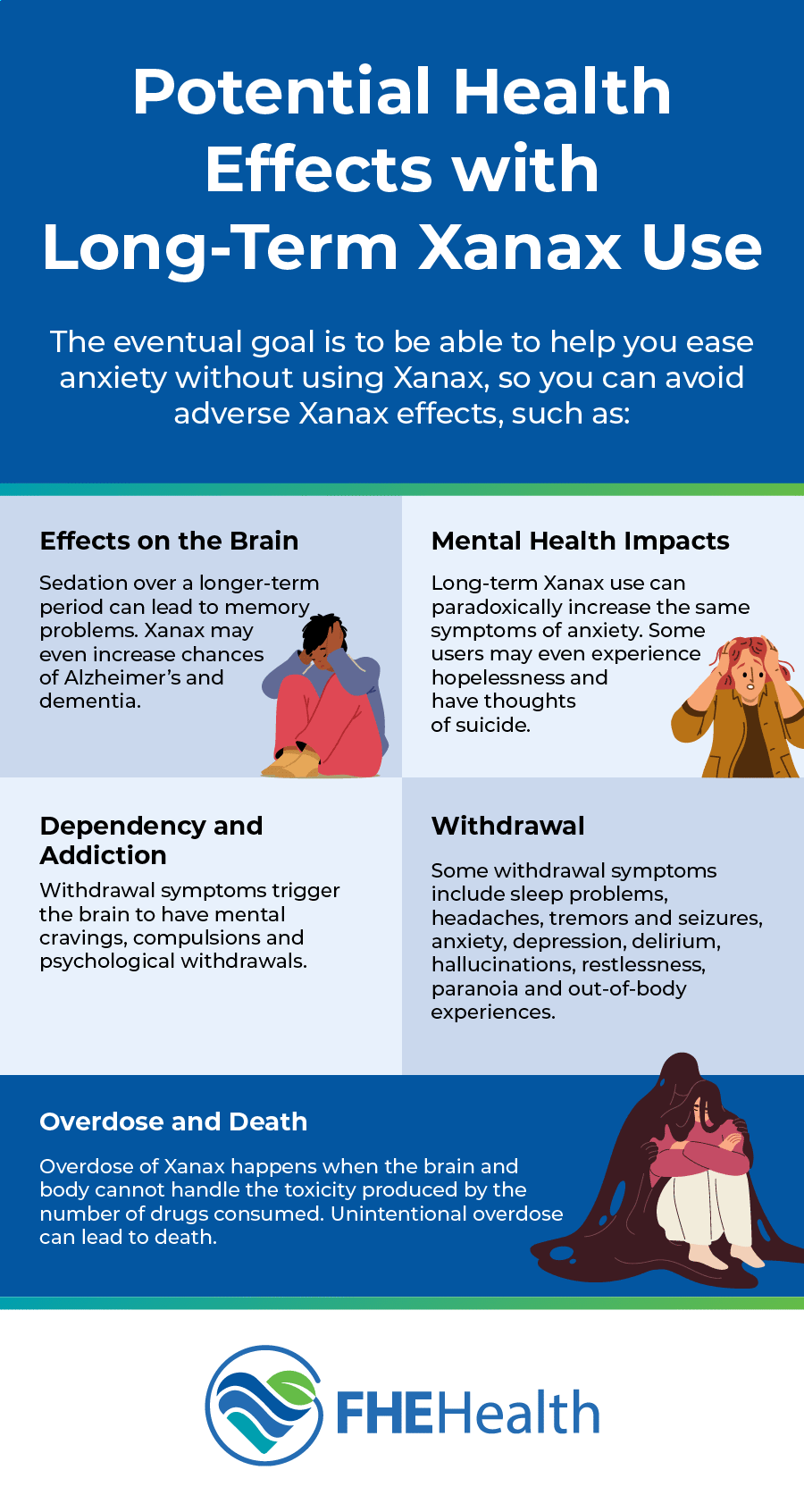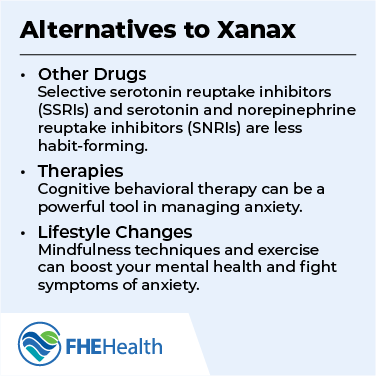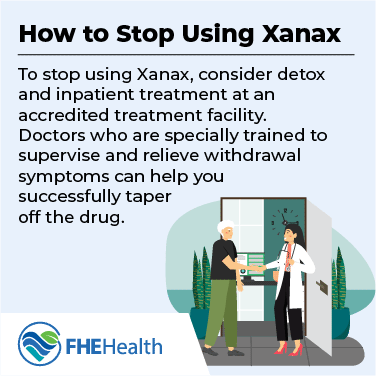
Many people take one or more prescription drugs as part of their daily regimen and worry about the long-term health effects of these drugs. The commonly prescribed, anti-anxiety drug Xanax is a case in point.
This blog is the first in a series that examines popularly prescribed drugs for anxiety and depression and the potential consequences of long-term use. We’ll address people hesitance to start using these drugs and why typically the expectation when prescribing a drug like Xanax is that its use will be for a limited period of time.
Anxiety and Anxieties About Xanax
Anxiety makes it hard to concentrate. The persistent feeling of fear stops you from effectively completing tasks at work and home. Symptoms like heart palpitations, restlessness, shortness of breath, sweating and tightness in the throat create thoughts of a possible heart attack or, worse, death.
When you seek treatment, your doctor may prescribe anti-anxiety medication—specifically, Xanax, which may bring welcome, much-needed relief. In the beginning, all that matters is that the Xanax keeps anxiety at bay; no more panic attacks, no more digestive problems and no more missing out on life experiences.
However, taking Xanax for months or years causes many to wonder if it will affect health in the longer term, and it is natural to have these thoughts. Many users wonder if Xanax is bad for them.
The Anxiety and Depression Association of America reports more than 40 million people over the age of 18 in America experience an anxiety disorder. Treatment can include medicines called anxiolytics, like Xanax.
At FHE Health, we have seen a reduction in anxiety-related symptoms using Xanax. However, we follow a strict regimen that includes monitoring, combination treatments and eventual weaning off Xanax. Not everyone’s tapering timeline is the same either. It can depend on individual factors like the severity of an anxiety disorder, other co-occurring conditions, risks of addiction, the nature of symptoms and other considerations.
That said, for those who have questions about how long to take Xanax and its potential long-term health effects, the information may be helpful. Let’s start with a definition of Xanax and how it works.
Understanding Xanax
Xanax is a class of benzodiazepines used to treat anxiety-related disorders like generalized anxiety, phobias and panic disorder. Another name for Xanax is alprazolam, but many refer to it as simply “benzo.” (Benzo is a shortened version of “benzodiazepine,” the class of drugs to which Xanax belongs.)
Many factors must be take into account before prescribing benzos. They include the seriousness of the condition, other diagnosable conditions, history of benzo use or abuse, and other medications that could cause a negative interaction.
Any treatment plan that includes Xanax should also include a plan for discontinuing its use upon reaching treatment goals. Xanax is best used in combination with therapeutics, support and medical interventions. It is more typically used to treat anxiety as a temporary support.
Potential Health Effects with Long-Term Xanax Use
 The eventual goal is to be able to help you ease anxiety without using Xanax, so you can avoid adverse Xanax effects, like those below.
The eventual goal is to be able to help you ease anxiety without using Xanax, so you can avoid adverse Xanax effects, like those below.
1. Effects on the Brain
Xanax is good at providing calm during chaotic situations. It sedates the central nervous system, relaxing your brain and body. Heart and respiratory rate slow. These calming effects can be extremely helpful at the beginning of treatment when a person is just beginning to learn new coping skills.
Sedation over a longer-term period can lead to memory problems, however. Some reports suggest Xanax can increase chances of Alzheimer’s and dementia. The longer your brain is on Xanax, the more it will adapt and continue to slow functioning throughout the mind and body.
Long-term use of Xanax may also lead to mental health issues.
2. Mental Health Impacts
Xanax releases higher levels of the neurotransmitter dopamine into the brain, making you feel pleasure. Over time, this excitement diminishes in the brain. Some users may even experience hopelessness and have thoughts of suicide.
Those who had depression before they began taking Xanax may also experience mania that is mostly associated with bipolar disorder. Mood swings between depression and mania can be extreme and interfere with daily functioning.
Long-term Xanax use can paradoxically increase the same symptoms of anxiety that it was originally prescribed to treat. One example of this phenomenon is rebound anxiety, a condition in which increased anxiety returns in between doses. Xanax is a short-acting drug, and it only lasts for a few hours. In the absence of healthy coping skills, anxiety can feel like it is getting worse each time the medication’s calming effects subside.
Rebound anxiety is one reason people become addicted and dependent on Xanax.
3. Dependency and Addiction
Tolerance for Xanax can increase over the course of just a few weeks. Higher doses or more frequent doses will then be needed to feel the desired effect.
Physical dependence caused by long-term use of Xanax means the body has gotten used to having the drug in its system. When the brain and body realize they have gone without Xanax, withdrawal symptoms appear. The body now needs the medication to function.
Withdrawal symptoms trigger the brain to have mental cravings, compulsions and psychological withdrawals. This is a clear sign of addiction.
Unfortunately, long-term use of Xanax tends to correlate with high rates of abuse. With nearly 50 million prescriptions given annually, the likelihood of misuse is high.
4. Withdrawal
Prolonged Xanax use, or misuse, leads to more severe withdrawal effects.
How bad is Xanax withdrawal? Withdrawal symptoms can be both psychological and physical. Examples of symptoms are sleep problems, headaches, tremors and seizures. Further symptoms include anxiety, depression, delirium, hallucinations, restlessness, paranoia and out-of-body experiences.
On top of those symptoms, long-term Xanax users can experience protracted withdrawal. This type of withdrawal is prolonged and produces waves of psychological symptoms that come and go for a year or longer.
Xanax abuse can also lead to much worse consequences, including overdose and death.
5. Overdose and Death
Overdose of Xanax happens when the brain and body cannot handle the toxicity produced by the number of drugs consumed. Factors that can contribute to an overdose, other than the amount taken, include age, weight, other medical conditions, and whether Xanax is mixed with other substances like alcohol.
Unintentional overdose can lead to death. According to the National Institute on Drug Abuse, 9,711 people died from a Xanax overdose in 2019.
No one sets out to be a long-time user of Xanax. As many have learned, quitting Xanax cold turkey can have dangerous, life-threatening consequences too. However, with the rights steps, you can overcome addiction safely.
Alternatives to Xanax
 Xanax and other benzodiazepine drugs can be effective options for treating anxiety in the short term. However, as you may now know, they carry many risks and are not sustainable for long-term anxiety management. The good news is that there are safer alternatives for managing anxiety symptoms. Many of these alternative options are just as effective—if not more effective—than Xanax.
Xanax and other benzodiazepine drugs can be effective options for treating anxiety in the short term. However, as you may now know, they carry many risks and are not sustainable for long-term anxiety management. The good news is that there are safer alternatives for managing anxiety symptoms. Many of these alternative options are just as effective—if not more effective—than Xanax.
Other Drugs
Xanax and benzodiazepine drugs are not the only choice of anti-anxiety medication. When treating your anxiety symptoms, doctors may start you on benzodiazepines because they are fast-acting and produce an immediate improvement. Before you can develop a tolerance for Xanax, they may swap you to something less habit-forming. Some of the most popular choices are selective serotonin reuptake inhibitors (SSRIs) and serotonin and norepinephrine reuptake inhibitors (SNRIs).
These drugs are antidepressants that function by slowing down the reabsorption of the neurotransmitters serotonin and norepinephrine in the brain. That in turn increases the level and availability of these neurotransmitters in the brain.
Beta blockers are also common anxiety-fighting medications. Unlike Xanax or antidepressants, beta blockers were not originally designed to combat mental health symptoms. Their primary purpose is to reduce blood pressure by blocking the effects of the hormone epinephrine—which you may know as adrenaline.
It just so happens that blocking this hormone has the additional benefit of calming your body’s fight-flight-freeze response. This allows beta blockers to limit the physical effects of anxiety, like a rapid heart rate or trembling.
While these types of antidepressants and beta blockers do carry some potential side effects, they are far safer than long-term Xanax use. Most notably, don’t suddenly stop taking beta blockers, as this can cause serious cardiac issues.
Therapies
If you have been prescribed Xanax, you may already be undergoing some form of “talk therapy.” These therapies, such as cognitive behavioral therapy, are some of the most powerful tools we have in managing anxiety long-term.
By teaching you to identify negative thought patterns, a therapist can help you implement techniques to counter and reduce anxiety-inducing thoughts. Many professionals will also provide you with a toolbox of strategies that allow you to control your response to feelings of anxiety and become better at managing anxiety-inducing situations when they pop up.
Lifestyle Changes
As strange as it might sound, another great alternative to taking Xanax is to simply make a few changes to your lifestyle. Sometimes, we lead lives that don’t promote healthy mindsets or worse, actively harm our mental health.
Mindfulness techniques have helped millions of people manage their anxiety symptoms. Some people use meditation or yoga as their mindfulness exercise, while others find that listening to music, reading, or simply going for a walk helps clear their minds. Breathing techniques and grounding exercises are also extremely popular.
Exercise, in general, is proven to boost your mental health and fight symptoms of anxiety and depression, as is getting enough sleep. Beyond that, try to eat a healthy diet full of all the nutrients your body needs. It might surprise you how often a nutritional deficiency can contribute to mental health struggles.
How to Stop Using Xanax
 To stop using Xanax, consider detox and inpatient treatment at an accredited treatment facility. Doctors who are specially trained to supervise and relieve withdrawal symptoms can help you successfully taper off the drug while helping you feel as safe and comfortable as possible. That, in turn, can allow you to focus on therapies that will teach you healthy techniques for managing anxiety.
To stop using Xanax, consider detox and inpatient treatment at an accredited treatment facility. Doctors who are specially trained to supervise and relieve withdrawal symptoms can help you successfully taper off the drug while helping you feel as safe and comfortable as possible. That, in turn, can allow you to focus on therapies that will teach you healthy techniques for managing anxiety.
A good inpatient (residential) treatment center should offer evidence-based treatments like cognitive behavioral therapy, which helps patients maintain sobriety from benzos and other substances.
At FHE Health, our goal is to treat the whole person and their unique needs, so they can find lasting independence from Xanax and other habit-forming substances. To take the next step to a life free of Xanax, reach out today at 844-223-0014. Our caring counselors can answer questions about addiction, long-term effects of Xanax use, treatments and the recovery process.






